Newgrange
Newgrange (Irish: Sí an Bhrú[1]) is a prehistoric monument in County Meath, Ireland, located 8 kilometres (5.0 mi) west of Drogheda on the north side of the River Boyne.[2] It is an exceptionally grand passage tomb built during the Neolithic period, around 3200 BC, making it older than Stonehenge and the Egyptian pyramids.
Sí an Bhrú | |
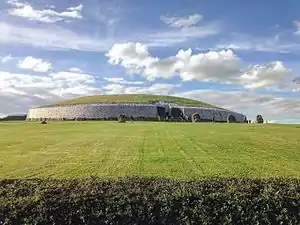 | |
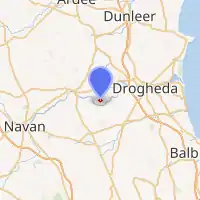
| |
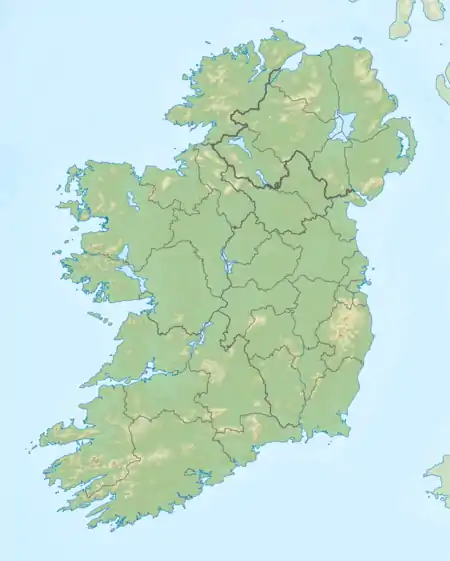 Map of Ireland showing the location of Newgrange | |
| Location | County Meath, Ireland |
|---|---|
| Coordinates | 53°41′41″N 6°28′32″W |
| Type | passage grave |
| Width | 76 metres' diameter (cairn) |
| Area | 1.1 acre (0.5 hectare) |
| Height | up to 12 metres |
| History | |
| Founded | c. 3200 BC |
| Periods | Neolithic |
| Site notes | |
| Excavation dates | 1962–1975 |
| Archaeologists | Michael J. O'Kelly |
| Ownership | Office of Public Works |
| Public access | yes (guided tour only) |
| Official name | Brú na Bóinne – Archaeological Ensemble of the Bend of the Boyne |
| Type | Cultural |
| Criteria | i, iii, iv |
| Designated | 1993 (17th session) |
| Reference no. | 659 |
| Region | Europe |
The site consists of a large circular mound with an inner stone passageway and chambers. Human bones and possible grave goods or votive offerings were found in these chambers. The mound has a retaining wall at the front, made mostly of white quartz cobblestones, and it is ringed by engraved kerbstones. Many of the larger stones of Newgrange are covered in megalithic art. The mound is also ringed by a stone circle. Some of the material that makes up the monument came from as far away as the Mournes and Wicklow Mountains. There is no agreement about what the site was used for, but it is believed that it had religious significance. Its entrance is aligned with the rising sun on the winter solstice, when sunlight shines through a 'roofbox' located above the passage entrance and floods the inner chamber. Several other passage tombs in Ireland are aligned with solstices and equinoxes, and Cairn G at Carrowkeel has a similar 'roofbox'.[3][4] Newgrange also shares many similarities with other Neolithic constructions in Western Europe, especially Gavrinis in Brittany, which has both a similar preserved facing and large carved stones, in that case lining the passage within.[5] Maeshowe in Orkney, Scotland, with a large high corbelled chamber,[6] and Bryn Celli Ddu in Wales have also been compared to Newgrange.
It is the most famous monument within the Neolithic Brú na Bóinne complex, alongside the similar passage tomb mounds of Knowth and Dowth, and as such is a part of the Brú na Bóinne UNESCO World Heritage Site. There are many smaller archaeological sites such as henges, mounds and standing stones situated in the .75 km between Newgrange and the Boyne.[7] Newgrange consists of approximately 200,000 tonnes of rock and other materials. It is 85 metres (279 ft) wide at its widest point.[8]
After its initial use, Newgrange was sealed for several millennia. It continued to feature in Irish mythology and folklore, in which it is said to be a dwelling of the deities, particularly The Dagda and his son Aengus. Antiquarians first began its study in the seventeenth century, and archaeological excavations took place at the site in the years that followed. Archaeologist Michael J. O'Kelly led the most extensive of these and also reconstructed the frontage of the site in the 1970s, a reconstruction that is controversial and disputed.[9] Newgrange is a popular tourist site and, according to the archaeologist Colin Renfrew, is "unhesitatingly regarded by the prehistorian as the great national monument of Ireland" and as one of the most important megalithic structures in Europe.[10]
Physical description
Mound and passage structure
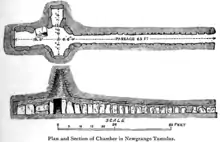
The Newgrange monument primarily consists of a large mound, built of alternating layers of earth and stones, with grass growing on top and a reconstructed facade of flattish white quartz stones studded at intervals with large rounded cobbles covering part of the circumference. The mound is 76 metres (249 ft) across and 12 metres (39 ft) high, and covers 4,500 square metres (1.1 acres) of ground. Within the mound is a chambered passage, which may be accessed by an entrance on the southeastern side of the monument. The passage stretches for 19 metres (60 ft),[11] or about a third of the way into the centre of the structure. At the end of the passage are three small chambers off a larger central chamber with a high corbelled vault roof. Each of the smaller chambers has a large flat "basin stone" where the bones of the dead may have been deposited during prehistoric times. Whether it was a burial site remains unclear. The walls of this passage are made up of large stone slabs called orthostats, twenty-two of which are on the western side and twenty-one on the eastern side. They average 1½ metres in height;[12] several are decorated with carvings (as well as graffiti from the period after the rediscovery). The orthostats decrease in height the further into the passageway as a result of the passage being slightly graded from being constructed on the rise of a hill.[13] The ceiling shows no evidence of smoke.
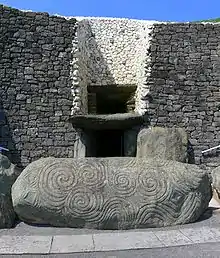
Situated around the perimeter of the mound is a circle of standing stones. Twelve standing-stones survive out of a possible original thirty-five or thereabouts. Most archaeologists suggest that they were added later, during the Bronze Age, centuries after the original monument had been abandoned as a ritual centre.
Art
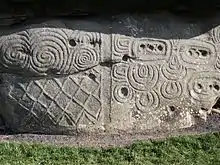
_(2).jpg.webp)
Newgrange contains various examples of graphic Neolithic rock art carved onto its stone surfaces.[14] These carvings fit into ten categories, five of which are curvilinear (circles, spirals, arcs, serpentiniforms, and dot-in-circles) and the other five of which are rectilinear (chevrons, lozenges, radials, parallel lines, and offsets). They are marked by wide differences in style, the skill-level needed to produce them, and on how deeply carved they are.[15] One of the most notable types of art at Newgrange are the triskele-like features found on the entrance stone. It is approximately three metres long and 1.2 metres high (10 ft long and 4 ft high), and about five tonnes in weight. It has been described as "one of the most famous stones in the entire repertory of megalithic art."[16] Archaeologists believe that most of the carvings were produced prior to the stones being erected, although the entrance stone was carved in situ before the kerbstones were placed alongside it.[17]
Various archaeologists have speculated as to the meanings of the designs, with some, such as George Coffey (in the 1890s), believing them to be purely decorative, whilst others, such as Michael J. O'Kelly (who led the 1962–1975 excavation at the site), believed them to have some sort of symbolic purpose, because some of the carvings had been in places that would not have been visible, such as at the bottom of the orthostatic slabs below ground level.[18] Extensive research on how the art relates to alignments and astronomy in the Boyne Valley complex was carried out by American-Irish researcher, Martin Brennan.
History
The Neolithic people who built the monument were native agriculturalists, growing crops and raising animals such as cattle in the area where their settlements were located.
Construction and burials
The original complex of Newgrange was built between c. 3200 and 3100 BC.[19] According to carbon-14 dates,[20] it is approximately five hundred years older than the current form of Stonehenge and the Great Pyramid of Giza in Egypt, as well as predating the Mycenaean culture of ancient Greece.[21] Some put its period of construction somewhat later, at 3000 to 2500 BC.[22] Geological analysis indicates that the thousands of pebbles that make up the cairn, which together would have weighed about 200,000 tonnes, came from the nearby river terraces of the Boyne. There is a large pond in this area that is believed to be the site quarried for the pebbles by the builders of Newgrange.[23] Most of the 547 slabs that make up the inner passage, chambers, and the outer kerbstones are greywacke. Some or all of them may have been brought from sites approximately 5 km away,[24] from the rocky beach at Clogherhead, County Louth, about 20 km to the northeast. The facade and entrance were built with white quartz cobblestones from the Wicklow Mountains, about 50 km to the south; dark rounded granodiorite cobbles from the Mourne Mountains, about 50 km to the north; dark gabbro cobbles from the Cooley Mountains; and banded siltstone from the shore at Carlingford Lough.[24] The stones may have been transported to Newgrange by sea and up the River Boyne by fastening them to the underside of boats at low tide.[25][26] None of the structural slabs were quarried, for they show signs of having been weathered naturally, so they must have been collected and then transported, largely uphill, to the Newgrange site.[23] The granite basins found inside the chambers also came from the Mournes.[24]
Frank Mitchell suggested that the monument could have been built within a space of five years, basing his estimation upon the likely number of local inhabitants during the Neolithic and the amount of time they could have devoted to building it rather than farming. This estimate, however, was criticised by Michael J. O'Kelly and his archaeological team, who believed that it would have taken a minimum of thirty years to build.[27]
Excavations have revealed deposits of both burnt and unburnt human bone in the passage, indicating human corpses had been placed within it, some of whom had been cremated. From examining the unburnt bone, it was shown to come from at least two separate individuals, but much of their skeletons were missing, and what was left had been scattered about the passage.[28] Various grave goods were deposited alongside the bodies inside the passage. Excavations that took place in the late 1960s and early 1970s revealed seven 'marbles', four pendants, two beads, a used flint flake, a bone chisel, and fragments of bone pins and points.[29] Many more artifacts had been found in the passage in previous centuries by visiting antiquarians and tourists, although most of these were removed and went missing or held in private collections. Nonetheless, sometimes these were recorded and it is believed that the grave goods that came from Newgrange were typical of Neolithic Irish passage grave assemblages.[30] The remains of animals also have been found in the structure, primarily those of mountain hares, rabbits, and dogs, but also of bats, sheep, goats, cattle, song thrushes, and more rarely, molluscs and frogs. Most of these animals would have entered and died in the chamber many centuries or even millennia after it was constructed: for instance, rabbits were only introduced to Ireland in the thirteenth century.[31]
.JPG.webp)
During much of the Neolithic period, the Newgrange area continued to be a focus of some ceremonial activity. In the Late Neolithic, it appears that Newgrange was no longer being used by the local population, who did not leave any artifacts in the structure or bury their dead there. As the archaeologist Michael J. O'Kelly stated, "by 2000 [BC] Newgrange was in decay and squatters were living around its collapsing edge".[32] These people were adherents of the Beaker culture, which had been imported from mainland Europe, and made Beaker-style pottery locally.[32] A large timber circle (or henge) was built to the southeast of the main mound and a smaller timber circle to the west. The eastern timber circle consisted of five concentric rows of pits. The outer row contained wooden posts. The next row of pits had clay linings and was used to burn animal remains. The three inner rows of pits were dug to accept the animal remains. Within the circle were post and stake holes associated with Beaker pottery and flint flakes. The western timber circle consisted of two concentric rows of parallel postholes and pits defining a circle 20 metres (66 ft) in diameter. A concentric mound of clay was constructed around the southern and western sides of the mound that covered a structure consisting of two parallel lines of post and ditches that had been partly burnt. A free-standing circle of large stones was raised around the Newgrange mound. Near the entrance, seventeen hearths were used to set fires. These structures at Newgrange are generally contemporary with a number of henges known from the Boyne Valley, at Newgrange Site A, Newgrange Site O, Dowth Henge, and Monknewtown Henge.
The site evidently continued to have some ritual significance into the Iron Age. Among various objects later deposited around the mound are two pendants made from gold Roman coins of 320–337 AD (now in the National Museum of Ireland) and Roman gold jewellery including two bracelets, two finger rings, and a necklace, now in the collections of the British Museum.[33]
Purpose
There have been various debates as to its original purpose. Many archaeologists believed that the monument had religious significance of some sort or another, either as a place of worship for a "cult of the dead" or for an astronomically-based faith. The archaeologist Michael J. O'Kelly, who led the 1962–1975 excavations at the site, believed that the monument had to be seen in relation to the nearby Knowth and Dowth, and that the building of Newgrange "cannot be regarded as other than the expression of some kind of powerful force or motivation, brought to the extremes of aggrandizement in these three monuments, the cathedrals of the megalithic religion."[34] O'Kelly believed that Newgrange, alongside the hundreds of other passage tombs built in Ireland during the Neolithic, showed evidence for a religion that venerated the dead as one of its core principles. He believed that this "cult of the dead" was just one particular form of European Neolithic religion, and that other megalithic monuments displayed evidence for different religious beliefs that were solar-oriented, rather than ancestor-oriented.[34]
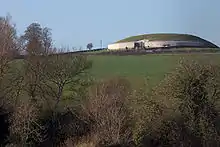
Studies in other fields of expertise offer alternative interpretations of the possible functions, however, which principally centre on the astronomy, engineering, geometry, and mythology associated with the Boyne monuments. It is speculated that the sun formed an important part of the religious beliefs of the Neolithic people who built it. One idea was that the room was designed for a ritualistic capturing of sun rays on the shortest day of the year, the Winter Solstice, as the room gets flooded with sunlight, which might have signaled that the days would start to get longer again. This view is strengthened by the discovery of alignments in Knowth, Dowth, and the Lough Crew Cairns leading to the interpretation of these monuments as calendrical or astronomical devices.
Formerly, the Newgrange mound was encircled by an outer ring of immense standing stones, of which twelve of a possible thirty-seven remain. Evidence from carbon dating suggests that the stone circle which encircled Newgrange may not be contemporary with the monument however, but was placed there some 1,000 years later in the Bronze Age. This view is disputed and relates to a carbon date from a standing stone setting that intersects with a later timber post circle, the theory being, that the stone in question could have been moved and later, re-set in its original position. This research implies a continuity of use of Newgrange of over a thousand years; with partial remains found from only five individuals, some question the tomb theory for its purpose.
Once a year, at the Winter Solstice, the rising sun shines directly along the long passage, illuminating the inner chamber and revealing the carvings inside, notably the triple spiral on the front wall of the chamber. This illumination lasts for approximately 17 minutes.[4] Michael J. O'Kelly was the first person in modern times to observe this event on 21 December 1967.[35] The sunlight enters the passage through a specially contrived opening, known as a roofbox, directly above the main entrance. Although solar alignments are not uncommon among passage graves, Newgrange is one of few to contain the additional roofbox feature. (Cairn G at Carrowkeel Megalithic Cemetery is another, and it has been suggested that one can be found at Bryn Celli Ddu.[36]) The alignment is such that although the roofbox is above the passage entrance, the light hits the floor of the inner chamber. Today the first light enters about four minutes after sunrise and strikes the middle of the chamber, but calculations based on the precession of the Earth show that 5,000 years ago, first light would have entered exactly at sunrise and shone on the chamber's back wall.[37] The solar alignment at Newgrange is very precise compared to similar phenomena at other passage graves such as Dowth or Maes Howe in the Orkney Islands, off the coast of Scotland.
Discovery, excavation and restoration
Mythology and folklore during Medieval and Early Modern periods
During the medieval period, Newgrange and the wider Brú na Bóinne Neolithic complex gained various attributes in local folklore,[38] which was often connected to figures from wider Irish mythology. The monuments of the Brú were thought of by some as being the abode of the supernatural Tuatha Dé Danann, whilst others considered them to be the burial mounds of the ancient kings of Tara. Amongst those who believed the folkloric tales relating the Brú to the Tuatha Dé Danann, it was commonly thought that they were the abode of the most powerful of the Tuatha, particularly The Dagda, his wife Boann, and his son, Oengus. According to the eleventh-century Book of Lecan, the Dagda had built the Brú for use by his family, whilst the twelfth-century Book of Leinster describes how Oengus tricked his father into giving him the Brú for all eternity. Another text, The Pursuit of Diarmaid and Grainne also implies that Oengus owned the Brú, when he declared how he took his friend Diarmaid to it.[39]
Sometime after 1142 the structure became part of outlying farmland owned by the Cistercian Abbey of Mellifont. These farms were referred to as 'granges'. Newgrange is not mentioned in any of the early charters of the twelfth and thirteenth centuries, but an Inspeximus granted by Edward III in 1348 includes a Nova Grangia among the demesne lands of the abbey.[40]
On 23 July 1539, following the Dissolution of the Monasteries by Henry VIII, Mellifont Abbey and its demesnes became the fortified mansion of an English soldier of fortune, Edward Moore, ancestor of the Earls of Drogheda.[41]
On 14 August 1699, Alice Moore, Countess Dowager of Drogheda, leased the demesne of Newgrange to a Williamite settler, Charles Campbell, for 99 years.[42]
Antiquarianism during seventeenth and eighteenth centuries

In 1699, a local landowner, Charles Campbell, ordered some of his farm labourers to dig up a part of Newgrange, which then had the appearance of a large mound of earth, so that he could collect stone from within it. The labourers soon discovered the entrance to the tomb within the mound, and a Welsh antiquarian named Edward Lhwyd, who was staying in the area, was alerted and took an interest in the monument. He wrote an account of the mound and its tomb, describing what he saw as its "barbarous sculpture" and noting that animal bones, beads, and pieces of glass had been found inside of it (modern archaeologists have speculated that these latter two were in fact the polished pottery beads that subsequently have been found at the site and that were a common feature of Neolithic tombs).[43] Soon another antiquarian visitor, Sir Thomas Molyneaux, professor at the University of Dublin, also came to the site. He talked to Charles Campbell, who informed him that he had found the remains of two human corpses in the tomb, one (which was male) in one of the cisterns and another farther along the passageway, something that Lhwyd had not noted.[44] Subsequently, Newgrange was visited by a number of antiquarians, who often performed their own measurements of the site and made their own observations, which often were published in various antiquarian journals; these included such figures as Sir William Wilde, Thomas Pownall, Thomas Wright, John O'Donovan, George Petrie, and James Ferguson.[45]
These antiquarians often concocted their own theories about the origins of Newgrange, many of which have since been proved incorrect. Thomas Pownall conducted a very detailed survey of New Grange in 1769,[46] which numbers all the stones and also records some of the carvings on the stone and asserted that the mound originally had been taller and a lot of the stone on top of it had been removed, a theory that has been disproven by archaeological research.[47] The majority of these antiquarians also refused to believe that it was ancient peoples native to Ireland who built the monument, with many believing that it had been built in the early medieval period by invading Vikings, whilst others speculated that it had been built by the ancient Egyptians, ancient Indians, or the Phoenicians.[48]
Modern conservation, archaeological investigation and reconstruction
.jpg.webp)
At some time in the early 1800s, a folly was built a few yards behind Newgrange. The folly, with two circular windows, was made of stones taken from Newgrange. In 1882, under the Ancient Monuments Protection Act, Newgrange and the nearby monuments of Knowth and Dowth were taken under the control of the state, and placed under the responsibility of the Board of Public Works. In 1890, under the leadership of Thomas Newenham Deane, the board began a project of conservation of the monument, which had been damaged through general deterioration over the previous three millennia as well as the increasing vandalism caused by visitors, some of whom had inscribed their names on the stones.[49] In subsequent decades, a number of archaeologists performed excavations at the site, discovering more about its function and how it had been built; however, even at the time, it was still mistakenly believed by archaeologists to be built during the Bronze Age rather than during the earlier Neolithic period.[50] In the 1950s, electric lighting was installed in the passageway to allow visitors to see more clearly,[51] whilst an exhaustive archaeological excavation was undertaken from 1962 through to 1975, the excavation report of which was written by Michael J. O'Kelly and published in 1982 by Thames and Hudson as Newgrange: Archaeology, Art and Legend.[52]
Following the O'Kelly excavation, further restoration and reconstruction took place at the site. Based on the positions of the cobblestones, and after conducting experiments, O'Kelly concluded that they had made up a retaining wall, but had fallen from the face of the mound. As part of the restoration, this wall was "rebuilt" and the cobblestones were fixed into a near-vertical steel-reinforced concrete wall surrounding the front of the mound. This work is controversial among the archaeological community. P. R. Giot described the monument as looking like a "cream cheese cake with dried currants distributed about."[53] Neil Oliver described the reconstruction as "a bit brutal, a bit overdone, kind of like Stalin does the Stone Age".[54] Critics of the new wall claim that the technology to fix a retaining wall at this angle did not exist when the mound was created. Another theory is that some, or all, of the white quartz cobblestones had formed a plaza on the ground at the entrance. This theory was preferred at nearby Knowth, where the restorers laid the quartz stones out as an "apron" in front of the entrance to the great mound.
The inward-curving dark stone walls on each side of the entrance are not original, nor are they intended to suggest Newgrange's original appearance, but were designed solely to facilitate visitor access. A visitor guide book to the site, however, has a reconstruction drawing depicting Neolithic inhabitants using Newgrange that shows the modern entrance as if it were part of Newgrange's original appearance.[55]
The culture that built Newgrange is sometimes confused with the much later Celtic culture, and designs on the stones are misdescribed as "Celtic".[56] However, recent archaeogenetics suggests that the west European neolithic population was largely replaced by later arrivals.[57] A recent article reports on the DNA of a middle-aged man who proved to be "the adult son of a first-degree incestuous union from remains that were discovered within the most elaborate recess of the Newgrange passage tomb." The article argues that this sanctioned incest characterizes small elites; they found that DNA taken from bones discovered in two other mounds prove that they were distant relatives of this man.[58]
Location and access
Newgrange is located 8.4 kilometres (5.2 mi) west of Drogheda in County Meath. The interpretive centre is located on the south bank of the river and Newgrange is located on the north side of the river. Access is only from the interpretive centre.
Access to Newgrange is by guided tour only. Tours begin at the Brú na Bóinne Visitor Centre from which visitors are taken to the site in groups.[59] Current-day visitors to Newgrange are treated to a guided tour and an re-enactment of the Winter Solstice experience through the use of high-powered electric lights situated within the tomb. The finale of a Newgrange tour results in every visitor standing inside the tomb where the tour guide then turns off the lights, and then turns on ones simulating the sunlight that would appear on the winter solstice.
To experience the phenomenon on the morning of the Winter Solstice from inside Newgrange, visitors to Bru Na Bóinne Visitor Centre must enter an annual lottery at the centre. Of the tens of thousands who enter, sixty are chosen each year. Winners are permitted to bring a single guest. The winners are split into groups of ten and taken in on the five days around the solstice in December when sunlight can enter the chamber, weather permitting.[60] (Due to the COVID-19 pandemic, however, the 2020 event shall be exclusively live-streamed with no public access.) [61]
Pictures
 Orthostat-lined passage leading towards the tomb chamber
Orthostat-lined passage leading towards the tomb chamber Decorated and cracked roof stone of the east side-chamber
Decorated and cracked roof stone of the east side-chamber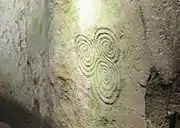 Triskele (triple spiral) pattern on orthostat C10 in the end-chamber
Triskele (triple spiral) pattern on orthostat C10 in the end-chamber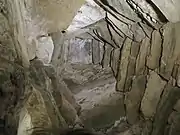 Corbelled ceiling of the end-chamber
Corbelled ceiling of the end-chamber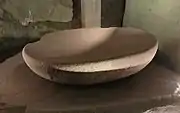 A chiselled granite basin in the east side-chamber
A chiselled granite basin in the east side-chamber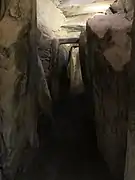 Passage leading out from the end-chamber
Passage leading out from the end-chamber
References
- "Sí an Bhrú /Newgrange". logainm.ie. Retrieved 27 April 2015.
- O'Kelly, Michael J. 1982. Newgrange: Archaeology, Art and Legend. London: Thames and Hudson. p. 13.
- Carrowkeel Cairn G. The Megalithic Portal.
- "The Winter Solstice Illumination of Newgrange". Archived from the original on 31 May 2017. Retrieved 2 November 2017.
- O'Kelly and O'Kelly, 102
- Laing 1974, p. 42
- Lynch, Ann (2014). "Newgrange revisited: New insights from excavations at the back of the mound in 1984–8". The Journal of Irish Archaeology. 23: 13–82 – via JSTOR.
- Hensey (2015). First Light: The origins of Newgrange. Oxbow Books. p. 13.
- "Newgrange got new lease of light and life in 1960s 'rebuild'". Irish Times. 20 December 2008.
- Renfrew, Colin, in O'Kelly, Michael J. 1982. Newgrange: Archaeology, Art and Legend. London: Thames and Hudson. p. 7.
- "Newgrange". newgrange.com. Retrieved 27 April 2015.
- O'Kelly (1982:21)
- Hensey, Robert (2017). "Rediscovering the winter solstice alignment at Newgrange, Ireland". The Oxford Handbook of Light in Archaeology.
- Joseph Nechvatal, Immersive Ideals / Critical Distances. LAP Lambert Academic Publishing. 2009, p. 163
- O'Kelly (1982:146–147).
- Ó Ríordáin, Seán P.; Glyn, Edmund Daniel (1964). New Grange and the Bend of the Boyne. F.A. Praeger. p. 26.
- O'Kelly (1982:149).
- O'Kelly (1982:148).
- "Newgrange". Department of Arts, Heritage, Regional, Rural and Gaeltacht Affairs. Retrieved 28 July 2016.
- E. Grogan, "Prehistoric and Early Historic Cultural Change at Brugh na Bóinne", Proceedings of the Royal Irish Academy 91C, 1991, pp. 126–132
- O'Kelly (1982:48)
- Grant, Jim; Sam Gorin; Neil Fleming (2008). The archaeology coursebook. Taylor & Francis. p. 159. ISBN 978-0-415-46286-0. Retrieved 17 August 2011.
- O'Kelly (1982:117)
- Tilley, Christopher. Body and Image: Explorations in Landscape Phenomenology. Left Coast Press, 2008. p.160
- Benozzo, F. (2010). "Words as Archaeological Finds: A Further Example of the Ethno-Philological Contribute to the Study of European Megalithism". The European Archaeologist. 33: 7–10.
- Phillips, W.E.A.; M. Corcoran; E. Eogan (2001), Identification of the source area for megaliths used in the construction of the Neolithic passage graves of the Boyne Valley, Co. Meath. Unpublished report for the Heritage Council., Department of Geology, Trinity College Dublin, archived from the original on 12 December 2011, retrieved 29 November 2011
- O'Kelly (1982:117–118)
- O'Kelly (1982:105–106)
- O'Kelly (1982:105)
- O'Kelly (1982:107)
- O'Kelly (1982:215–216)
- O'Kelly (1982:145).
- "British Museum – Collection search". British Museum. Retrieved 27 April 2015.
- O'Kelly (1982:122)
- "Brú na Bóinne (Newgrange, Knowth and Dowth)". Archived from the original on 12 October 2007. Retrieved 12 October 2007.
- Pitts (2006) Sensational new discoveries at Bryn Celli Ddu. British Archaeology No. 89 (July/August): 6.
- Ray, T. P. (January 1989). "The winter solstice phenomenon at Newgrange, Ireland: accident or design?". Nature. 337 (6205): 343–345. Bibcode:1989Natur.337..343R. doi:10.1038/337343a0. S2CID 4349872.
- "Cuardach téacs". dúchas.ie (in Irish). Retrieved 1 December 2020.
- O'Kelly (1982:43–46)
- "An Important Mellifont Document." Journal of the County Louth Archaeological Society, vol. 14, no. 1, 1957, pp. 1–13.
- Geraldine Stout, Newgrange and the Bend of the Boyne, Cork University Press, Cork (2002), pp. 85, 102
- Stout (2002:128)
- O'Kelly (1982:24)
- O'Kelly (1982:27)
- O'Kelly (1982:33–34)
- Archaeologia Vol 2, 1773. A Description of the Sepulchral Monument of New Grange, near Drogheda, in the County of Meath, in Ireland. By Thomas Pownall, Esq. in a letter to the Rev. Gregory Sharpe, D.D. Master of the Middle Temple. Read at the Society of Antiquaries, 21/28 June 1770. Archaeologia Vol 2, pp. 236–276
- O'Kelly (1982:33)
- O'Kelly (1982:35)
- O'Kelly (1982:38–39)
- O'Kelly (1982:42)
- O'Kelly (1982:41)
- O'Kelly (1982:09)
- Giot, P.-R. (1983). "Review: Newgrange: archaeology, art and legend". Antiquity. 57 (220): 150.
- "A History of Ancient Britain" Series 1 episode 3, "Age of Cosmology", BBC documentary, 2011.
- Alan Marshall, "Newgrange Excavation Report Critique"
- "History of Newgrange Stone Age Passage Tomb in Ireland". 21 March 2010.
- Reich D. Who we are and how we got here; Oxford UP (2018) pp. 98, 114–117.
- Cassidy, Lara M.; Maoldúin, Ros Ó; Kador, Thomas; Lynch, Ann; Jones, Carleton; Woodman, Peter C.; Murphy, Eileen; Ramsey, Greer; Dowd, Marion; Noonan, Alice; Campbell, Ciarán (18 June 2020). "A dynastic elite in monumental Neolithic society". Nature. 582 (7812): 384–388. Bibcode:2020Natur.582..384C. doi:10.1038/s41586-020-2378-6. ISSN 1476-4687. PMID 32555485. S2CID 219729757.
- Heritage Ireland
- "Winter Solstice | Brú na Bóinne | World Heritage | World Heritage Ireland". www.worldheritageireland.ie. Retrieved 26 August 2020.
- https://www.gov.ie/en/news/eea6b-winter-solstice-at-newgrange-2020/#
External links
| Wikimedia Commons has media related to Newgrange. |
- Official website
- Information on Newgrange by Meath Tourism
- Irish passage tombs and other Neolithic monuments
- 101 Facts About Newgrange
- Newgrange.eu
- Windows Media recording of the 2007 Winter Solstice event
- Short Video by National Geographic about Newgrange.
- MegalithicIreland.com
- Brú na Bóinne in myth and folklore
- Newgrange winter solstice simulation in 3D
- Calendrical Interpretation of Spirals in Irish Megalithic Art on Arxiv.org 19 March 2019.
